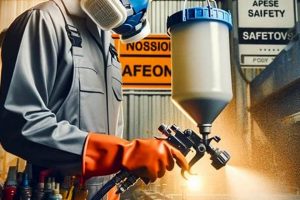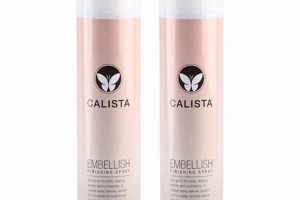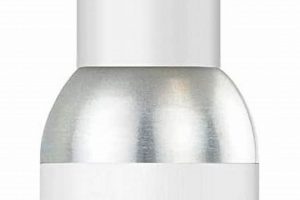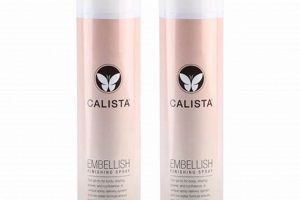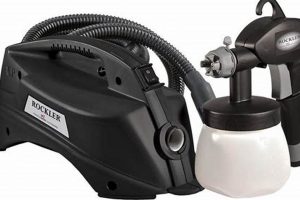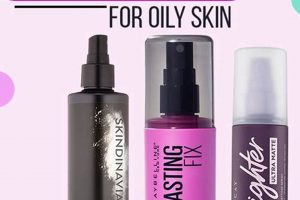A surface coating applied via pressurized atomization results in a smooth, even layer. This application method propels the coating material through the air in a fine mist, allowing for uniform coverage on a variety of substrates. An example would be applying lacquer to a wooden cabinet using a specialized piece of equipment.
This technique offers several advantages, including increased speed and efficiency compared to brush application, reduced material waste, and the ability to achieve a flawless appearance. Historically, its development represented a significant advancement in manufacturing and finishing processes, allowing for mass production and improved product quality across numerous industries. The method quickly became valued for both its aesthetic appeal and protective qualities.
Further discussion will explore the various types of coating materials suitable for this application process, the equipment required, and techniques for achieving optimal results. Safety considerations and environmental impact will also be addressed.
Tips for Achieving Optimal Results with Sprayed Coatings
The following guidelines outline best practices for achieving a professional-grade appearance using the described application method, ensuring durability and aesthetic quality.
Tip 1: Surface Preparation is Paramount. Prior to application, thorough cleaning and preparation of the substrate are essential. Remove any existing contaminants, such as dirt, grease, or loose particles. Sanding may be necessary to create a keyed surface, promoting adhesion of the coating.
Tip 2: Material Viscosity Must Be Correctly Adjusted. Improper viscosity can lead to runs, sags, or an uneven texture. Consult the manufacturer’s specifications for thinning recommendations and use appropriate solvents. Always test the viscosity before commencing the application process.
Tip 3: Maintain Consistent Distance and Overlap. The distance between the spray nozzle and the surface should remain constant throughout the application. Overlap each pass by approximately 50% to ensure uniform coverage and prevent striping. Inconsistent distance and overlap can cause irregularities in the final product.
Tip 4: Control the Spray Pattern and Pressure. Adjust the spray gun settings to achieve the desired pattern width and material flow rate. Excessive pressure can result in bounce-back and overspray, while insufficient pressure may produce a coarse or textured result. Proper settings are crucial.
Tip 5: Apply Multiple Thin Coats. Multiple thin coats are preferable to a single thick coat. This technique minimizes the risk of runs, sags, and bubbles, allowing each layer to dry properly and build a durable finish. Patience is key.
Tip 6: Ensure Adequate Ventilation. Many coatings contain volatile organic compounds (VOCs) that can pose health risks. Work in a well-ventilated area or use a respirator to protect against inhalation of fumes. Safety should always be a priority.
Tip 7: Maintain Equipment Cleanliness. Regular cleaning of the spray gun and associated equipment is essential for optimal performance and longevity. Dried coating material can clog the nozzle and other components, affecting the spray pattern and material flow. Follow the manufacturer’s cleaning instructions.
These tips provide a foundational understanding of best practices, ultimately contributing to enhanced quality, reduced waste, and improved safety.
The subsequent sections will delve deeper into specific coating types and advanced techniques for achieving specialized finishes.
1. Even application
An even application is a fundamental characteristic and a direct consequence of properly executed pressurized atomization. The purpose of this coating method lies in its ability to dispense material uniformly across a surface. The success of this process is directly tied to the uniformity of the resulting layer. For example, in automotive manufacturing, inconsistent application of the clear coat could result in visible imperfections, such as orange peel texture or variations in gloss level. Such defects compromise the vehicle’s aesthetic appeal and potentially its protective qualities.
Achieving a coating of consistent thickness requires meticulous attention to detail throughout the entire process. This includes precise control of the equipment, appropriate material viscosity, and adherence to proper application techniques. For instance, fluctuating pressure settings can lead to uneven material distribution, resulting in variations in color or sheen. Similarly, incorrect nozzle positioning can create areas of over- or under-application, detracting from the overall finish. Understanding the delicate interplay of these factors is essential for consistently achieving an even and visually appealing outcome. In the aerospace industry, ensuring a consistently applied protective coat on aircraft components prevents corrosion and extends the lifespan of critical parts.
Ultimately, even application, achieved through mastery of the process, yields a professional and durable result. While challenges such as complex geometries and varying environmental conditions can impact consistency, a thorough understanding of the underlying principles and diligent execution can overcome these obstacles. The ability to create a uniform coating is not merely an aesthetic concern but a crucial factor in the performance and longevity of the coated item. The value in achieving this lies in its direct impact on durability, appearance, and long-term cost savings.
2. Material atomization
Material atomization represents a critical phase in the application process, dictating the uniformity and quality of the resulting layer. It is the conversion of a liquid coating material into a fine mist, enabling even distribution across a target surface. Without effective atomization, achieving a flawless and consistent appearance becomes improbable.
- Droplet Size and Distribution
The size and uniformity of the atomized droplets directly influence the smoothness and appearance of the finish. Smaller, consistently sized droplets lead to a more uniform coverage, minimizing imperfections like orange peel or runs. For instance, in high-gloss automotive coatings, consistent droplet size ensures a mirror-like reflection. Conversely, inconsistent droplet sizes result in a textured, uneven surface.
- Equipment and Nozzle Design
The selection of equipment, specifically the nozzle design, plays a crucial role in atomization quality. Different nozzle types, such as airless, air-assisted airless, and conventional air nozzles, produce varying droplet sizes and spray patterns. The optimal choice depends on the material being applied and the desired finish characteristics. An inappropriate nozzle can lead to incomplete atomization, resulting in defects. Examples include the utilization of an airless device for high-viscosity materials, or an air-assisted airless configuration for more delicate tasks.
- Pressure and Flow Rate Control
Maintaining precise control over pressure and flow rate is essential for consistent atomization. Fluctuations in pressure can cause variations in droplet size and spray pattern, leading to an uneven finish. Proper calibration of the equipment and consistent monitoring of these parameters are vital. This is important in the application of protective coatings on bridges, where consistent thickness and droplet size is required.
- Material Properties and Viscosity
The properties of the coating material, particularly its viscosity, significantly impact atomization. Higher viscosity materials require greater force to atomize effectively. Adjustments to thinning agents or heating may be necessary to achieve the desired droplet size and spray pattern. The type of solvent used will also influence atomization due to differences in volatility.
The principles underlying material atomization directly influence the outcome of any process. Effective management of droplet size, equipment, pressure, and material properties ensures a consistent, high-quality covering, preventing aesthetic defects and optimizing protective capabilities. Further research can include methods such as advanced ultrasonic techniques for achieving extremely fine atomization. In addition, computational fluid dynamics are used to optimize nozzle designs for creating uniform atomization.
3. Surface preparation
Surface preparation is foundational to achieving a durable and aesthetically pleasing coating using atomized application techniques. It directly influences the adhesion, smoothness, and longevity of the applied material. Inadequate surface preparation can compromise even the highest quality coatings, resulting in premature failure and aesthetic defects. This discussion outlines key aspects of surface preparation within this context.
- Cleaning and Degreasing
The removal of contaminants, such as dirt, oil, grease, and other residues, is paramount. These substances can interfere with coating adhesion, leading to peeling, blistering, or other surface defects. For example, failure to properly degrease metal components prior to coating in an automotive manufacturing setting can result in paint delamination and corrosion. Cleaning methods include solvent wiping, alkaline cleaning, and vapor degreasing.
- Sanding and Abrading
Creating a profiled surface through sanding or abrasion improves mechanical adhesion by increasing the surface area available for bonding. The appropriate grit and abrasion technique depend on the substrate material and the coating being applied. Sanding wood surfaces opens the grain, allowing better penetration and adherence. Improper sanding can create scratches or leave behind residue that inhibits adhesion.
- Priming and Sealing
The application of a primer serves to promote adhesion between the substrate and the topcoat, as well as to seal porous surfaces and prevent the absorption of the coating material. Primers are formulated to address specific substrate properties and compatibility with the chosen coating. Using an incompatible primer can lead to inter-coat adhesion issues, resulting in cracking or peeling. An example includes applying an epoxy primer to metal before applying a polyurethane topcoat to provide corrosion protection and promote adhesion.
- Repairing Surface Imperfections
Addressing imperfections such as scratches, dents, and cracks prior to application is crucial for achieving a smooth and uniform appearance. These defects can telegraph through the applied coating, detracting from the overall aesthetic and potentially compromising the protective qualities. Fillers, putties, and body fillers are used to level the surface before sanding and coating. Failure to properly address these imperfections will lead to visible defects in the finished product, even with multiple layers of coating.
The efficacy of the spray finish process is intrinsically linked to the diligence with which surface preparation is executed. From meticulous cleaning to careful repair of imperfections, each step contributes to the final outcome. Neglecting any of these elements can significantly reduce the lifespan and aesthetic appeal of the coated product. Understanding the specific requirements of the substrate and the coating material is essential for selecting the appropriate preparation methods.
4. Equipment calibration
Equipment calibration is a critical determinant in the efficacy of spray finish applications. It directly influences material flow, atomization quality, and spray pattern consistency. Deviations from specified parameters can result in a range of defects, including uneven coverage, excessive overspray, and compromised adhesion. The relationship is causal: improper calibration precipitates undesirable outcomes in the final finish. The precision achievable through the application relies heavily on the accuracy of the equipment settings.
In automotive painting, for instance, improper calibration of the nozzle pressure on an automated spray gun can lead to variations in paint thickness across the vehicle’s surface. Such inconsistencies may manifest as color mismatches or visible texture differences. Similarly, in the aerospace industry, where coatings serve a protective function against corrosion, inadequate calibration during application of these materials could result in localized areas of insufficient protection, thereby compromising the structural integrity of the aircraft. Regular calibration checks and adjustments, adhering to manufacturer guidelines, are necessary to maintain consistent performance.
Accurate equipment setup, validated through proper calibration, directly contributes to cost savings by minimizing material waste and rework. Furthermore, it ensures the consistent application of coatings within specified tolerances, a crucial factor in industries where stringent quality control measures are enforced. Understanding the practical significance of calibration allows for more efficient operation and a higher quality finished product. Therefore, calibration is not merely a procedural step, but an integral component of achieving a professional and durable spray finish.
5. Coating viscosity
Coating viscosity is a fundamental property that significantly impacts the success of any spray finish application. It describes a fluid’s resistance to flow, thereby dictating how a material atomizes, transfers, and levels on a surface. Proper viscosity is essential for achieving the desired finish characteristics, including smoothness, uniformity, and film build.
- Atomization Efficiency
Viscosity directly influences the ability to atomize a coating material into fine droplets. Higher viscosity fluids require greater energy to break into a mist, potentially resulting in larger droplet sizes and an uneven spray pattern. Lower viscosity fluids atomize more easily but may be prone to excessive sagging or running. For example, applying a high-solids epoxy coating with insufficient thinning can lead to poor atomization, resulting in a textured, orange-peel finish. Conversely, over-thinning a lacquer can cause runs and a lack of film build. The correct viscosity ensures consistent atomization, promoting a smooth and uniform covering.
- Flow and Leveling
Viscosity affects the flow and leveling properties of a coating after it has been applied to a surface. A fluid with appropriate viscosity will flow smoothly, filling minor imperfections and creating a level finish. If the viscosity is too high, the coating may retain brush marks or exhibit poor leveling. If too low, it may sag or run. For instance, in furniture finishing, a self-leveling varnish requires precise viscosity to flow out evenly and eliminate brushstrokes. Balancing viscosity optimizes the flow characteristics, producing a defect-free appearance.
- Film Build and Sag Resistance
The viscosity of a coating material influences the thickness of the applied film. Higher viscosity coatings tend to provide greater film build per coat, while lower viscosity coatings require multiple applications to achieve the same thickness. However, high viscosity can also lead to increased sag resistance, preventing the coating from running or dripping on vertical surfaces. In industrial applications, a high-build epoxy coating used for corrosion protection must strike a balance between viscosity for adequate film thickness and sag resistance to ensure uniform coverage on complex geometries. Careful adjustment prevents both insufficient protection and undesirable application defects.
- Application Method Compatibility
Different spray application methods, such as airless, air-assisted airless, and conventional air spray, are suited for specific viscosity ranges. Airless systems are generally used for higher viscosity coatings, while conventional air spray is better suited for lower viscosity materials. Attempting to use an incompatible application method can result in poor atomization, excessive overspray, or other defects. Selecting the correct application method and adjusting the viscosity accordingly is vital for achieving optimal results.
In conclusion, coating viscosity is a crucial parameter in achieving a successful spray finish. It impacts atomization, flow, film build, and application method compatibility. Careful consideration of viscosity, with adjustments made based on material properties and application requirements, is essential for producing a durable, aesthetically pleasing, and functional finish. An understanding of these underlying relationships facilitates efficient application and reduces the likelihood of defects.
6. Environmental control
Environmental control is integral to achieving a high-quality spray finish. Temperature, humidity, and airflow directly influence coating viscosity, drying time, and the likelihood of defects. Deviations from recommended parameters can compromise adhesion, smoothness, and overall durability. Therefore, managing these environmental factors is not merely a peripheral consideration but a crucial aspect of the process. For instance, elevated humidity levels during the application of waterborne coatings can retard evaporation, leading to sags, runs, and a prolonged drying time. Conversely, excessively high temperatures can cause solvents to evaporate too rapidly, resulting in dry spray, poor leveling, and reduced gloss. Precise control minimizes these risks.
Specific examples illustrate the practical importance of environmental control. In automotive refinishing, consistent temperature and humidity levels within the spray booth are essential for achieving a uniform color match and preventing solvent popping, a defect caused by trapped solvent vapor. In the manufacturing of electronic components, temperature-controlled cleanrooms ensure that conformal coatings are applied without contamination from airborne particles. The effects of proper environmental regulation are also observed in wood finishing, where controlling humidity prevents moisture-related issues such as cracking or warping. Across industries, proper environmental control contributes to efficient application, reduced material waste, and a superior final product.
In conclusion, environmental control is not a discretionary step but a necessity for obtaining consistent and reliable spray finishes. Recognizing the cause-and-effect relationship between environmental factors and coating performance allows for proactive management, minimizing defects and maximizing the lifespan and aesthetic appeal of the finished product. While challenges exist in achieving perfect control, implementing appropriate measures, such as temperature and humidity monitoring, ventilation systems, and cleanroom environments, represents a worthwhile investment in product quality.
Frequently Asked Questions About Spray Finish
The following section addresses common questions and misconceptions regarding the application method known as “spray finish,” providing concise and informative answers.
Question 1: What are the primary advantages of spray application compared to brush or roller application?
Spray application offers several benefits including increased speed, more uniform coverage, the ability to reach intricate surfaces, and reduced risk of brushstrokes or roller marks.
Question 2: What types of materials can be applied using spray application methods?
A wide range of materials can be applied, including paints, lacquers, varnishes, stains, urethanes, and various protective coatings. Material compatibility with the application equipment must be verified before use.
Question 3: What factors contribute to achieving a smooth and even surface?
Key factors include proper surface preparation, correct material viscosity, consistent spray technique, appropriate equipment settings, and a controlled environment.
Question 4: What safety precautions should be observed when working with materials using spray application?
Adequate ventilation is essential to minimize inhalation of harmful vapors. The use of a respirator or approved mask is often necessary. Protective clothing and eye protection are also recommended. Fire hazards should be mitigated by eliminating ignition sources and maintaining a clean work environment.
Question 5: What is the difference between airless and conventional air methods?
Airless methods atomize the material by forcing it through a small nozzle at high pressure. Conventional air methods use compressed air to shear the material into a fine mist. Each method offers distinct advantages depending on the material, application requirements, and desired finish characteristics.
Question 6: How does humidity affect the final result when utilizing spray application?
High humidity can prolong drying times and cause moisture-related defects such as blushing or blooming, particularly with certain coating types. Lower humidity may accelerate drying but can also increase the risk of dry spray. Optimal humidity levels should be maintained according to the coating manufacturer’s recommendations.
In summary, achieving a successful outcome with this method requires careful attention to surface preparation, material selection, equipment operation, and safety practices.
The following section provides information on troubleshooting common issues encountered during the application process.
Spray Finish
This exploration has detailed the fundamental aspects of the topic, from material atomization and surface preparation to the critical roles of equipment calibration, controlled viscosity, and environmental regulation. The quality and durability of a coating applied using these techniques are not simply a matter of chance. Rather, they are direct results of careful planning, diligent execution, and a comprehensive understanding of the underlying principles that govern the process.
The attainment of consistent and superior results demands a commitment to precision and adherence to best practices. Continued research, technological advancements, and a dedication to refinement will further enhance its effectiveness across diverse industries and applications. Therefore, professionals should remain vigilant in their pursuit of knowledge and mastery of these techniques to uphold the integrity and longevity of coated materials.


